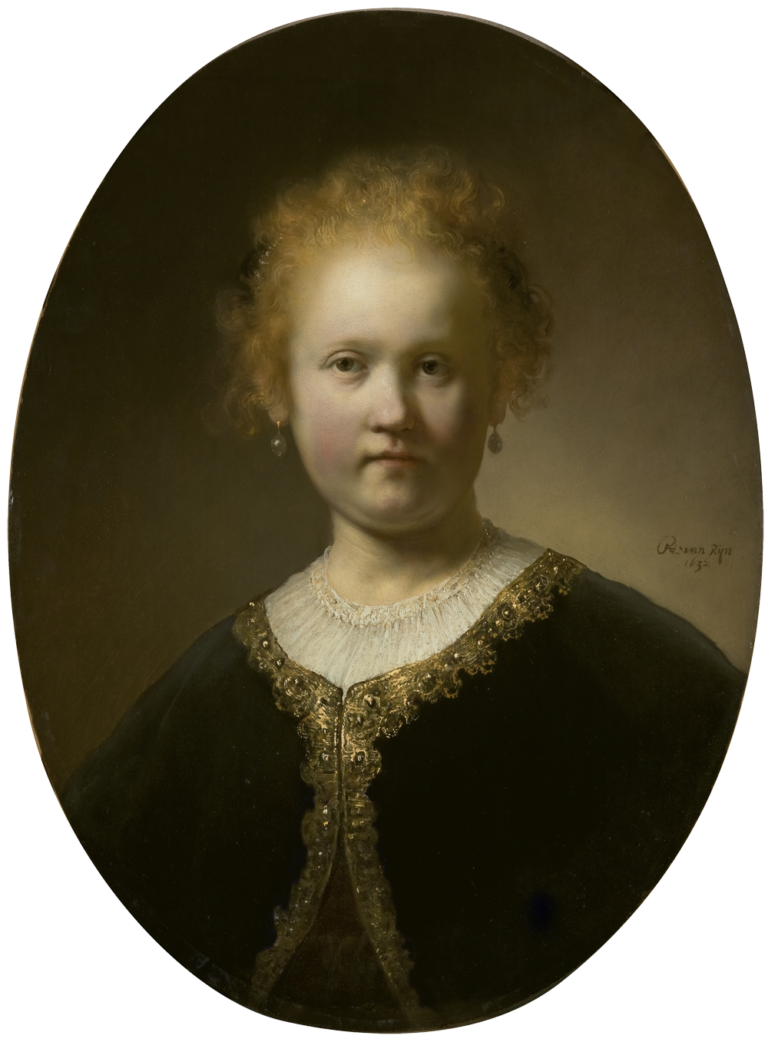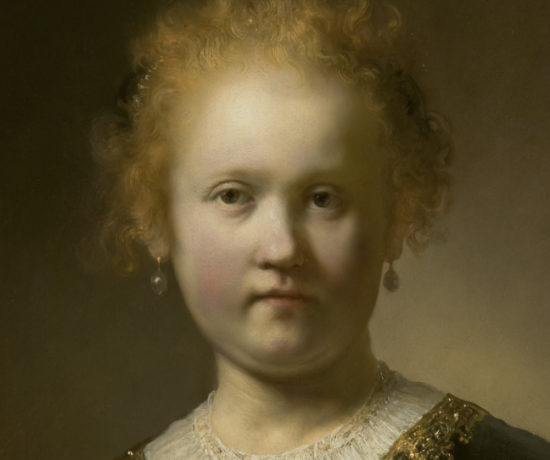One of the miracles of Rembrandt van Rijn’s paintings of individuals is that the expressions of his sitters never seem frozen. Even their personalities seem to evolve as one interacts with their gazes. These qualities are particularly evident in this charming depiction of an elegantly robed young girl with curly, somewhat frizzy blond hair. Although she stares directly at the viewer from the center of this oval panel, the slight twist of her body, with one shoulder higher than the other, helps soften her formal appearance. Light falling from the upper left also enlivens her presence by picking up nuances of her features, including her pronounced forehead, her somewhat asymmetrical eyes, the slight pout of her mouth, and the beginnings of a double chin. The shaded right side of her face, moreover, seems to recede more deeply into space than her lit side, a subtle difference in structure that adds character to her face. Even the color shifts in the ocher background, as Rembrandt plays with light against dark and dark against light, help create the sense that she is a living and breathing individual with a personality far more lively than first intimated by her restrained pose.
Rembrandt enhanced the pictorial character of the image with his distinctive painting techniques. He modeled the girl’s flesh tones with smoothly blended strokes, and rendered her blond hair with flowing, individual touches of the brush. He vigorously applied heavily laden paint to create the pattern of radial pleats of the white blouse, whereas he picked out the decorative motifs of the gold embroidery on her black gown with thick highlights. Finally, Rembrandt’s carefully placed accents lend weight and substance to the strand of pearls in her hair and the single pearl hanging from her right ear.
Rembrandt painted Young Girl in a Gold-Trimmed Cloak in 1632, soon after he moved from Leiden to Amsterdam, at a time when his portraits and tronies (imaginative character studies of individual figures) were in great demand.1 It is oftentimes difficult to tell the difference between these two types of paintings, as Rembrandt infused both with personal characterizations that seem distinctive and reflective of a specific individual. This issue is particularly relevant for Young Girl in a Gold-Trimmed Cloak, which has often been identified as a portrait but should instead be considered a tronie.
The sitter is most frequently identified as Saskia Uylenburgh, Rembrandt’s first wife.2 However, Rembrandt and Saskia probably did not meet until a year after this painting was executed.3 Moreover, a comparison of the sitter in this painting and the silverpoint drawing Rembrandt made of Saskia in Friesland in 1633 on the occasion of their engagement (fig 1) reveals clear differences. The girl in the Leiden Collection painting, for instance, has a more rounded head and more childlike features. Another proposed identification for the sitter is Rembrandt’s younger sister Elisabeth (Lysbeth).4 However, Rembrandt executed this painting in Amsterdam and Lysbeth apparently spent her whole life in Leiden, where she was buried in the Pieterskerk in 1655.5
It is highly unlikely, indeed, that Rembrandt has here painted a formal portrait of a specific individual, family member or not.6 Even apart from the problems inherent in the above proposed identifications, there is the issue of the figure’s dress. Her outfit, with its high-necked, pleated, white blouse and dark cloak edged with gold embroidery, as well as the string of pearls in her hair and her pearl ear drops, harkens back to elegant sixteenth-century fashions.7 Such imaginative, fanciful outfits are characteristic of the tronies that Rembrandt and Jan Lievens (1607–74) depicted in Leiden during the late 1620s and early 1630s. These paintings, which came in different sizes and different degrees of finish, included depictions of young girls, wrinkled graybeards, weathered soldiers, and exotic potentates. They were made, in part, in preparation for history paintings, but also as works to be sold on the open market.
The same model appears in two other paintings that Rembrandt executed in 1632: A Young Woman in Profile with a Fan in Stockholm (fig 2) and Bust of a Young Woman in a Cap in a private collection in Switzerland.8 In the Stockholm painting she is shown in strict profile to the left and wears similar clothing and pearl jewelry.9 In the other painting, likewise signed and dated 1632, she wears a plumed beret.10 A fourth painting depicting the same model, Bust of a Young Woman in Chapel Hill (fig 3), was executed by one of Rembrandt’s studio assistants, probably Isaac de Jouderville (ca. 1612–48).11 The presence of these four paintings featuring the same model by Rembrandt, and his workshop makes it highly unlikely that Young Girl in a Gold-Trimmed Cloak was a commissioned portrait. Interestingly, the same model, in a nearly identical costume, appears in two of Rembrandt’s history paintings from the early 1630s: as Europa in The Rape of Europa, in the J. Paul Getty Museum, and as the woman (Esther?) in the Old Testament scene in Ottawa (fig 4).12
In the eighteenth century, Young Girl in a Gold-Trimmed Cloak was part of the distinguished collection of Jean de Jullienne (1686–1766) in Paris, where it was considered a pendant to the Chapel Hill painting, which is likewise oval in shape and has exactly the same dimensions.13 The first mention of these paintings as pendants occurs in the Catalogue des Tableaux de M. de Jullienne, ca. 1756, a room-by-room inventory of the paintings displayed in Jullienne’s Parisian hotel, illustrated with 152 miniatures in pen and watercolor (fig 5).14 It is unlikely, however, that these works were conceived as pendants. Not only were they executed on different types of wood (the Leiden Collection painting is on Spanish cedar, whereas the Chapel Hill painting is on oak), they differ stylistically and qualitatively.15 Even though Rembrandt’s pupil, presumably Isaac de Jouderville, must have had access to the same model, the physiognomic details of the Chapel Hill painting are softer and less vividly defined, and the lighting does not similarly set off the head and upper body from the background.16 Most importantly, she lacks the compelling presence that so endears her to all viewers of Rembrandt’s subtle masterpiece in the Leiden Collection.
The journey of Young Girl in a Gold-Trimmed Cloak through to its accession by the Leiden Collection is extremely well documented and quite fascinating. Sold in Paris in 1767 after the death of Jean de Jullienne, the painting spent more than a century in France before Furst Johannes II, prince of Liechtenstein acquired it by 1891. Between 1908 and 1929 it was in the collection of the Rt. Reverend Georgius Schmid von Gruneck, the bishop of Chur in Switzerland. In 1929, Robert Treat Paine II, a descendant of one of the signers of the Declaration of Independence, purchased the painting and then generously placed it on long-term loan at various museums so that it could be studied by scholars and enjoyed by a wide public. In 1975, however, Young Girl in a Gold-Trimmed Cloak was stolen from the Museum of Fine Arts, Boston, and the brazen character of the theft brought the painting great notoriety. The theft had been orchestrated by Myles J. Connor Jr., who, wearing a beard, glasses, a tweed suit and a fedora, escaped with the work, aided by accomplices firing shots at the steps of the museum.17 A year later the painting was recovered in dramatic fashion by state and federal officials who returned it to the museum, where it stayed until the family put it up for auction in 1986. That sale (to a private collector) compounded the painting’s fame because it sold for $10.5 million—a record for a work by the Dutch artist and the second highest price ever paid at auction for an Old Master painting.18 In 2007 this masterpiece was acquired in a private sale by the Leiden Collection (see Provenance).

